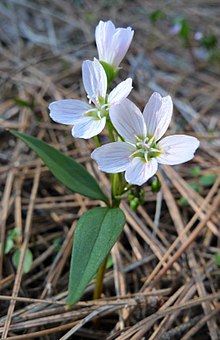Claytonia lanceolata
| Claytonia lanceolata | |
|---|---|

| |
| Scientific classification | |
| Kingdom: | Plantae |
| Clade: | Tracheophytes |
| Clade: | Angiosperms |
| Clade: | Eudicots |
| Order: | Caryophyllales |
| Family: | Montiaceae |
| Genus: | Claytonia |
| Species: | C. lanceolata |
| Binomial name | |
| Claytonia lanceolata | |
Claytonia lanceolata is a species of wildflower in the family Montiaceae, known by the common names lanceleaf springbeauty and western springbeauty.
Description
This somewhat rare plant[2] is native to western North America, growing in the sagebrush steppe[3] and foothills up to alpine slopes. It thrives in the rocky soil of alpine climates where the snow never melts.[4] It is a perennial herb growing from a tuber one to three centimeters wide. It produces a short, erect stem reaching a maximum height of 15 cm (6 in).[3] At its smallest the plant bears only its first two rounded leaves before flowering and dying back. Its thick leaves are helpful for storing water. If it continues to grow it produces two thick, lance-shaped leaves further up the stem.[3] The star-shaped flowers come in inflorescences of three to fifteen blooms and they are white or pink, often with veiny stripes[3] and yellow blotches near the base of each petal. The fruit is a small capsule containing a few seeds, which are black and shiny.[2]
Uses
The entire plant is edible raw or cooked,[5] including the potato-like corm from which it grows.[6] Some report that the bulbs must be cooked to remove toxins.[3]
Native Americans ate the roots and pods, which can be cooked and eaten like potatoes.[7] The leaves can be eaten raw or cooked.[8]
The Okanogan-Colville, Okanogan, and Nlaka'pamux Native American peoples used the tuber of this plant for food and for animal fodder.
Cultivation
Western spring beauty is occasionally grown in gardens by those interested in wildflower gardening. Outside their native habitat they will not persist if subjected to either extreme drying during the summer or being flooded during rainstorms.[9]
References
- ^ NatureServe (2023). "Claytonia lanceolata". NatureServe Explorer. Arlington, Virginia: NatureServe. Retrieved 1 May 2023.
- ^ a b Elias, Thomas S.; Dykeman, Peter A. (2009) [1982]. Edible Wild Plants: A North American Field Guide to Over 200 Natural Foods. New York: Sterling. p. 92. ISBN 978-1-4027-6715-9. OCLC 244766414.
- ^ a b c d e Taylor, Ronald J. (1994) [1992]. Sagebrush Country: A Wildflower Sanctuary (rev. ed.). Missoula, MT: Mountain Press Pub. Co. p. 122. ISBN 0-87842-280-3. OCLC 25708726.
- ^ "Claytonia lanceolata Lanceleaf Spring Beauty, Idaho springbeauty, Pacific springbeauty, Peirson's springbeauty PFAF Plant Database". pfaf.org. Retrieved 2021-12-11.
- ^ Benoliel, Doug (2011). Northwest Foraging: The Classic Guide to Edible Plants of the Pacific Northwest (Rev. and updated ed.). Seattle, WA: Skipstone. p. 147. ISBN 978-1-59485-366-1. OCLC 668195076.
- ^ Fagan, Damian (2019). Wildflowers of Oregon: A Field Guide to Over 400 Wildflowers, Trees, and Shrubs of the Coast, Cascades, and High Desert. Guilford, CT: FalconGuides. p. 62. ISBN 978-1-4930-3633-2. OCLC 1073035766.
- ^ Reiner, Ralph E. (1969). Introducing the Flowering Beauty of Glacier National Park and the Majestic High Rockies. Glacier Park, Inc. p. 24.
- ^ Nyerges, Christopher (2017). Foraging Washington: Finding, Identifying, and Preparing Edible Wild Foods. Guilford, CT: Falcon Guides. ISBN 978-1-4930-2534-3. OCLC 965922681.
- ^ Barr, Claude A. (1983). Jewels of the plains : wild flowers of the Great Plains grasslands and hills. Minneapolis: University of Minnesota Press. p. 60. ISBN 0-8166-1127-0.
External links
 Media related to Claytonia lanceolata at Wikimedia Commons
Media related to Claytonia lanceolata at Wikimedia Commons- Calflora Database: Claytonia lanceolata (Lanceleaf springbeauty, Western spring beauty)
- Jepson eFlora (TJM2) treatment of Claytonia lanceolata
- Ethnobotany
- UC CalPhotos gallery of Claytonia lanceolata

